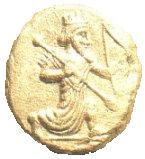The Angel of Death, aka the Destroyer, has the vibe of a divine Terminator. The clue is in the name: wherever the Angel of Death roams, death follows. It is this angel that God sends into Egypt as a deal breaker when Pharaoh insists on holding the Jews in Egypt against their will. God has already sent plagues of frogs, lice, boils, locusts and other nasties but when Pharaoh refuses to let the people go, God plays his trump card and the Angel of Death is mobilized to kill every firstborn human and animal in Egypt. Only families that daub lambs’ blood on the outside of their doorposts will be passed over unharmed. The night is a success: Pharaoh gives in, the Jews escape and the vibe is still remembered today as the Passover. However, Passover isn’t the Destroyer’s only outing, he is employed a couple of other times in the Bible. Israel’s King David is punished by God for wanting to know just how powerful a king he is and taking a head count of all his soldiers. The Angel of Death brings a plague that wipes out seventy thousand of these warriors. Later on, the aggressive Assyrian King Sennecharib is brought down to size by the Angel who lays waste to 180,000 troops who are about to attack Jerusalem. An inspiration to countless metal bands and writers of horror movies, the Angel of Death is God at his angriest, and not a vibe you want to meet face to face.
General vibe of the Angel of Death: the Destroyer
Factvibe: Some believe that the Angel of Death reappears in the book of Revelation as one of the four Horsemen of the Apocalypse

How much metal fans love the Angel of Death is evidenced by the millions of images such as this that proliferate the internet








